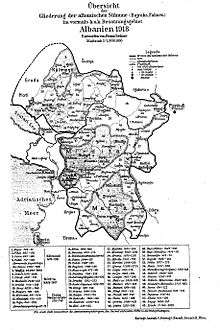Lumë (region)


Lumë (definite Albanian form: Luma) is an ethnographic region that extends itself in northeastern Albania and southwest Kosovo. It includes the village with the same name, Lumë, which lays in Albania. It is surrounded by Has region in the north and northwest, Fan and Orosh, Reçi and M’Ujë e m’Uja in the south, Reka, Gora and Opoja in the east, and Vërrini of Prizren in the north.[1] The region is home if an Albanian tribe with the same name.[2]
History
The region is documented first in the 16th century (1571 -1591), as a nahiye of the Sanjak of İpek, whereas in the 17th century it is mentioned by Frang Bardhi as the most eastern frontier of the Roman Catholic Diocese of Sapë.[1]
It is thought that before the 18th century the timar system was replaced by the self-governing system of bajrak.[3] Luma has had 7 bajraks:[1]
- Bajrak of Rrafsha (the bajraktar was centered in Bicaj),
- Bajrak of Tejdrina (the bajraktar was centered in Ujmisht and then in Domaj),
- Bajrak of Qafa (the bajraktar was centered in Bushtricë),
- Bajrak of Kalisi (the bajraktar was centered in Zallë-Kalis),
- Bajrak of Radomira (the bajraktar was centered in Tejs),
- Bajrak of Çaja (the bajraktar was centered in Fshat),
- Bajrak of Topojan (the bajraktar was centered in Brekijë).
The last organization of these bajraks was done in 1912 in the battle of Qafa e Kolesjanit, against the Serbian army.[1]
Notable people
- Baba Hajji Dede Reshat Bardhi - Grandfather of Bektashi Order
- Muharrem Bajraktari (1896 — 1989) - World War II fighter and politician
- Koca Sinan Pasha (1506 – 1596), Ottoman grand vizier, Ottoman military figure, and statesman
See also
- Battle of Lumë
- Lumë, one of the main settlements of the region
References
- 1 2 3 4 Fejzulla Gjabri (Department of Culture of Albania), Information about the Heroic Epos in the Province of Luma
- ↑ Robert Elsie (30 May 2015). The Tribes of Albania: History, Society and Culture. I.B.Tauris. pp. 281–282. ISBN 978-1-78453-401-1.
- ↑ HOXHA, Shefqet. "BAJRAKTARËT E LUMËS". Pashtriku. Retrieved 15 November 2015.
Megjithëse deri tani nuk është shpaluar ndonjë akt zyrtar i Perandorisë Osmane që ligjëronte zëvendësimin e sistemit të timarit në malësi me atë të njësive vetëqeverisëse tradicionale dhe si njësi administrative-ushtarake osmane me emrin "bajrak", ky proces mendohet të ketë nisur para shek.XVIII